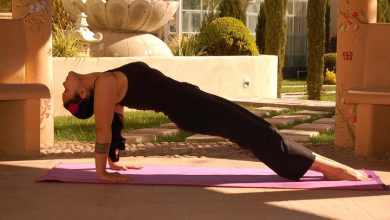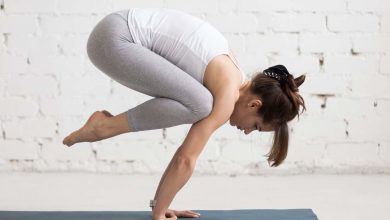How To Do Shoulder-Pressing Pose And What Are Its Benefits : Bhujapidasana
The Shoulder Pressing Pose or Bhujapidasana is known to be simple, yet it is only with practice that you get used to the pressure it exerts on the shoulders. Patience and perseverance will give you the stamina, strength, balance, and will power to master this asana.
What You Should Know Before You Do The Asana
This asana must be performed on an empty stomach. You must have your meals at least four to six hours before you practice yoga. You must also make sure that your bowels are empty. You must avoid this asana if you have injuries in your wrist, elbow, lower back, or shoulder. Avoid this asana even if you suffer from high blood pressure or cervical spondylitis.

How To Do The Bhujapidasana : Step-by-Step Instructions
- Begin this asana by squatting. Place your feet at a distance that is slightly lesser than the distance between your shoulders. Keep your knees wide.
- Angle your torso such that it faces forward, and place it between the inner thighs. As you lower your torso, your hips must be raised, such that they come in line with the floor.
- Place the upper left shoulder as close to the back area of the left thigh, a little above your knees. Once you have done this, place the left hand on the ground next to the outer part of your left foot. Do the same on your right side as well.
- This will make your upper back round up.
- Now that both your palms firmly press the ground, lift your body, placing its weight on your hands. The lifting happens because of a shift in the center of gravity.
- Press the outer part of your arms along with the inner thighs as you place the right ankle over your left ankle. Gaze forward. Hold the pose. Then, bend your elbows and release the pose as you exhale.
Tips
- Bring your awareness to where the upper arms and inner thighs touch. Squeeze your thighs in against your arms, while simultaneously pressing your arms out against your thighs. This will help you balance and hold the pose for longer.
- For all arm balances, I like to take a moment to consciously think, and silently say to myself, “my hands are my feet, my feet are my hands.”
- Balance equally on both hands, and distribute the weight evenly on each hand.
Look up, not down at your feet. - Be patient — most arm balances take dedicated practice, and some like Bhujapidasana can take years. Remember wherever you are in this pose and in your practice, is right where you’re meant to be.
Beginner’s Tip
As a beginner, it might be hard to get into this pose. If you are attempting this asana but find it hard to keep up your balance, use a block or bolster to support your sitting bones.
Modifications & Variations
As your practice and advance in this pose, you may attempt the full expression of the pose. All you need to do is lean forward so that your chin moves towards the ground. Always remember, you should never rush into the advancement. You will know when you are ready, and then, the progression becomes effortless.
Benefits Of The Bhujapidasana
- This asana helps improve a sense of balance and concentration.
- It makes the wrists, shoulders, arms, and upper body strong.
- The abdomen gets a good stretch, and therefore, digestion is improved.
- This asana nourishes the thyroid gland. Therefore, the heart rate is controlled, the nervous system is balanced, and metabolism is regulated.
- The blood circulation is improved.
- This asana helps relieve stress and headache.
Preparatory Poses
Bakasana
Baddha Koṇasana
Malasana
Garudasana
Follow-Up Poses
Adho Mukha Svanasana
Uttanasana
Urdhva Mukha Svanasana
Now that you know how to do Bhujapidasana, what are you waiting for? Let the binding of the shoulder press release your trapped emotions and inhibitions and set you free.




